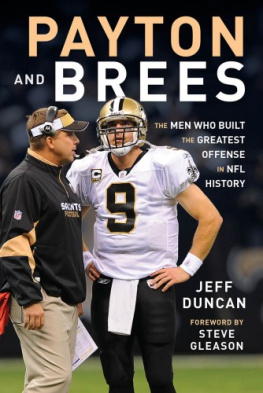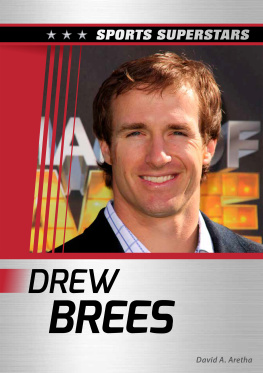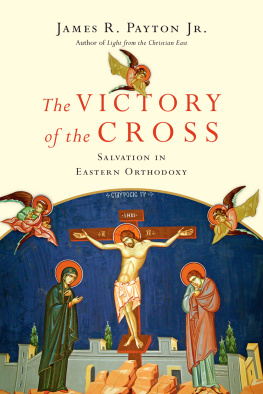This book is dedicated to Saints fans and the people of the great city of New Orleans, who deserve leaders like Drew Brees and Sean Payton.
Contents
Foreword by Steve Gleason
I met Sean Payton and Drew Brees 14 years ago, in 2006. At the time, the Saints and the city of New Orleans were just in the initial stages following the agonizing destruction of Hurricane Katrina. I played on the team for the previous six seasons and had fallen in love with the unique culture of this communitynot to mention a daughter of the community I found uniquely loveable. While I was confident the people of New Orleans would recover resiliently, I was not so sure about the Saints organization. I had more pressing personal concerns. The family of my future wife, Michel Varisco, had their home completely destroyed. Even more personally, when Coach Payton first set eyes on me in the Saints cafeteria, he assumed I was just a long-haired team equipment manager.
Along with Michels family and the city of New Orleans, I was working to find a return to success after a really difficult year following Hurricane Katrina. Ultimately, Drew Brees and Sean Payton would be the catalysts of that returnour collective rebirth.
From a personal perspective 14 years later, I consider Coach Payton and Drew Brees my brothers. Yeah, I convinced Payton that I was more than an equipment manager during 2006 training camp. But three years after I retired from the NFL, I was diagnosed with ALS, a hurricane of a disease. Painful and agonizing. Brees and Payton have been immensely supportive of me both publicly and privately. I am so grateful for their friendship. I love them.
At some point during the Saints team and organizations transition, the phrase We will walk together forever emerged. I have remained in New Orleans and I am raising a family with Michel. Coaches and players have come and gone, as we all do, but for the past 14 years, I have gotten to see Drew and Coach at the facility, or the Dome, or Mardi Gras, or a fundraiser, or even at the house. Both of these guys ushered in a change of plans, a change of mind-set, and a change of heart, not only with the Saints organization, but the entire New Orleans region. In a completely unprecedented way, since the 2006 season, the people of this city, region, and state can all proudly say, We will walk together forever.
I played all eight years of my NFL career with the New Orleans Saints. I made the team after a free-agent tryout midway through the 2000 season. It was your standard workout: 40-yard dash, bench press, standing long jump, agility drills. Afterward, the scouts took me and the other tryout players for a meal before our flights back home. I was surprised at their choice of dining establishment: a grungy restaurant with bars on the windows in a neglected neighborhood that served cold fried chicken from a buffet. To say the least, it was not the kind of experience a first-class organization would project. It was a little thing. But it said a lot. I got a call a week later to join the team, and two weeks after that I was on the field with the Saints playing against John Elway and the Denver Broncos.
Payton and Brees joined the team six years later in the wake of Hurricane Katrina. Before they arrived in town, the Saints teams I played on were talented but inconsistent. On any given Sunday, we could beat the best team in the league or lose to the worst. My rookie year, maybe 10 weeks after eating a buffet lunch behind barred windows, we won our first playoff game in franchise history. But we lacked the discipline and consistency necessary to be great.
When Coach Payton took over the team in 2006, he knew he needed to change things in the organization. He knew the perception and results would not change until the culture did.
First, he had to determine what kind of culture the organization had enabled and fostered for the previous 38 years. This required him to create a sense of urgency, not only among the players, but also the existing Saints staff, management, and ownership. In an organization that seemed pretty content with mediocrity, this was a monumentally enormous task from my perspective.
I think Coach Payton knew that this would require bold action early in his tenure. For existing staff and front-office personnel, Payton ensured he and his coaches were treated in first-class fashion. He pushed for his staff members to have more favorable car lease agreements and disallowed business operations staffers to enter and interrupt coaches meetings. Coach Payton wanted his coaches to be treated like company executives.
For the players, Coach Payton wanted to push the level of urgency. To set the tone, he hung signs around the training facility. The first sign I saw read: S AINTS P LAYERS W ILL B E S MART, T OUGH, D ISCIPLINED, AND W ELL- C ONDITIONED . It made me laugh. In an industry where players are coveted for their size, speed, and strength, I had doubts that this message was sincere. Messages like this became the theme. The coaches and management were continuously thinking about what these signs should say, underscoring their importance. They regularly changed and replaced them, sending the message that these principles were not simply collecting dust on the wall. It struck me as smart, a good first impression.
Early in the spring he made another strong impression. He told the team there was a three-year timeframe for drafted players. In Year One, players were given the benefit of the doubt as they were rookies or new to the team system. In Year Two, a transition to production would need to be observed. In Year Three, players would be at a crossroads with the team and should probably update their rsum if they werent being productive. He was creating a sense of urgency with every player on the roster.
Additionally, he promised that high-level decisions that turned out to be incorrect would not be supported simply to satisfy egos or balance the books. Marques Colston exemplified this philosophy. Colston was a seventh-round draft pick out of Hofstra who clearly outperformed former first-round pick Dont Stallworth during training camp. The Saints traded Stallworth midway through training camp and elevated Colston to the starting lineup. Message sent. No players roster spot was guaranteedregardless of the amount of money invested in the individual player. As a former undrafted free agent who was trying to make an impression on the new coach, I already felt plenty of urgency. But I was reassured by Paytons actions. He meant what he said about the best players making the team. I felt I had a chance to be one of those players. Coach Paytons ability to persuade management to make the correct team decisions was refreshing.
Coach Payton also instituted a disciplinary system that consistently fined players for small transgressions like missing meetings or being overweight. These fines were reported every morning at the team meeting and no further oration was implemented. Players were not given exemption, and the fines were generally preceded by a simple statement like, These rules had been developed and agreed upon by the team. This may not seem like a large factor in successful change, but as a player I saw it as vital. Not surprisingly, the discipline statistics in our games (penalties, mental errors, etc.) were greatly reduced as this change took place. The night before our first preseason game in 2006, Coach Payton made another strong impression. We were bused to a hotel in Jackson, Mississippi. When I was given my key, I went to my room and noticed the place smelled of mothballs and there was a hole in the sheetrock. This was early in the change effort, and I had my doubts there would be any real change with the new coach. This hotel solidified my doubts. We assembled a couple hours later for a team meeting and I anticipated Coach Paytons reaction, if any, to the hotel quality. Impressively, he stood in front of the team and not only apologized for the hotel but promised with confidence and sincerity that we would never stay in a hotel like this while he was the head coach.
Next page








